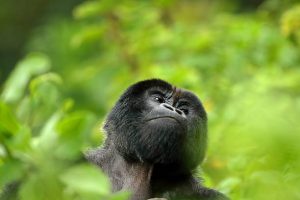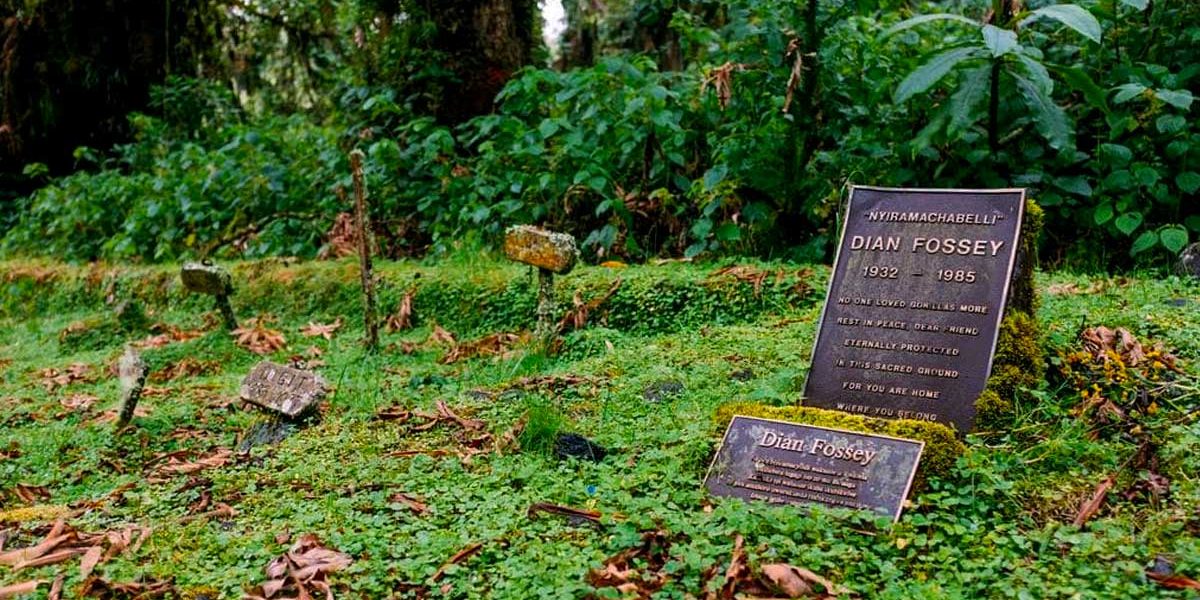Karisoke Research Centre in Volcanoes National Park
Karisoke Research Centre was the main headquarters of the conservation works of Dian Fossey during the time she was living in the Volcanoes National Park. Dian Fossey, after arriving at the Virunga National Park in the Democratic Republic of Congo, began her work studying the endangered mountain gorillas. However, her work was cut short by the political instabilities in the Virunga National Park. This forced her to flee to Rwanda and settle in Volcanoes National Park. She arrived at Volcanoes National Park in Rwanda on the 24th of September, 1967.
Upon arrival in the Volcanoes National Park, Dian Fossey set up her camp of two tents where she resided and did her work. These tents were located between Mount Karisimbi and Mount Bisoke. These two are part of the 5 of the eight Virunga mountains in Volcanoes National Park. She then named this camp she had created, Karisoke Research Centre.

Karisoke was derived from combining the names of these two mountains, Karisimbi and Bisoke. The then two-tent camp grew to become an international research center that focuses on mountain gorilla conservation. This transformation also surprised Dian Fossey, as she once said “Little did I know then that by setting up two small tents in the wilderness of the Virungas, I had launched the beginnings of what was to become an internationally renowned research station eventually to be utilized by students and scientists from many countries”. It is without a doubt that the Karisoke Research Centre was a baby birthed by Dian Fossey.
Who is Dian Fossey?
Talking about the Karisoke Research Centre often, one name always pops up every time, and I know many would wonder, who is Dian Fossey? Well, let’s uncover the mystery of Doctor Dian Fossey and why she is the most famous person in the mountain gorilla primate world.
Doctor Dian Fossey was born and raised in the state of San Francisco in the United States of America. She grew up with a passion for traveling and discovering new places and things, and this is what led her to study. After completing college, Dian Fossey borrowed funds and embarked on a trip around Africa. Starting from Kenya and Tanzania to Zimbabwe and later the Democratic Republic of Congo. While in the Virunga Mountains of the Democratic Republic of Congo, Dian Fossey camped behind other tourists and encountered mountain gorillas. She was fascinated by what she had seen and published her detailed experience in a journal. This introduced her to Leakey, who later funded her trip back to Africa to begin her research.
The Transformative Return of a Legendary Conservationist
Dian Fossey settled in the Virunga National Park in the Democratic Republic of Congo and became her work. To study the behaviors of the mountain gorillas, Dian Fossey needed to get closer to these primates. This led her to close association with the primates who later became familiar with her, hence easing her work. Hence, this was the birth of gorilla habituation.
Unfortunately, political instability in the Democratic Republic of Congo forced her to flee to Rwanda’s Volcanoes National Park. On 24th September 1967, she set up her camp in the park and named it Karisoke Research Centre. Dian Fossey became a primatology expert and conservationist who based her work on conserving the endangered mountain gorillas. This is why she openly and fearlessly fought poachers, and this earned her the name “mother of gorillas”. Unfortunately, her love for conserving these primates would later be her misfortune as tensions rose following the killing of a gorilla, Dian Fossey was murdered on the 23rd of December 1985. She was buried at the Karisoke Research Centre and today, visitors from across the world flock to Volcanoes National Park to pay their respect to the great primatologist of all time.
What to do in Volcanoes National Park?
Volcanoes National Park is located in the northern region of Rwanda, close to the border with Uganda and the Democratic Republic of Congo. Volcanoes National Park is part of the Virunga conservation area that stretches from the Virunga National Park. The park was established in 1925 and is the oldest park in Africa. It spans 160 square kilometers of tropical rainforest, hosting 5 of the 8 Virunga Mountains.
Gorilla trekking
This is the major tourist activity in Volcanoes National Park. Gorilla trekking refers to hiking through the tough terrain of the park and searching for mountain gorillas Additionally, it involves spending an hour with them after locating their habitat. It is an interesting activity that allows visitors a chance to encounter mountain gorillas in their habitat.
Hiking
Volcanoes National Park hosts Mount Karisimbi, Mount Bisoke, Mount Sabyinyo, Mount Muhavura, and Mount Gahinga. These mountains are part of the 8 mountains of the Virunga ranges. Hiking is also another tourist activity that allows visitors to explore these mountains. While hiking in Volcanoes National Park, visitors are met with epic sceneries of nature and also the flora and fauna.
Birding
Volcanoes National Park is home to over 200 bird species, and these bring life to the park with their endless melodies that cut across the mountains. These bird species can be encountered with an experienced guide birder with knowledge about the birds in the park. Some of the birds include Francolin, Rwenzori Turaco, Rwenzori Batis, and African Swamphen. Grey-headed Bush-shrike, Olive-belled, bat Hawk, brown backed-honey bird, Dusky crimsonwing, Archer’s ground robin, and red-chested sunbird among others.
What is the best time to visit Karisoke Research Centre in Volcanoes National Park?
Karisoke Research Centre is open for visiting all year round and is open to the public. However, the best time to visit would be the dry season, which runs from June to September and December to February. This is a dry period characterized by little or no rain since the park lies in the equatorial climate zone. Visitors can visit the Centre and experience the works of Doctor Dian Fossey and some of her preserved works. This visit can be combined with gorilla trekking in the Volcanoes National Park.












